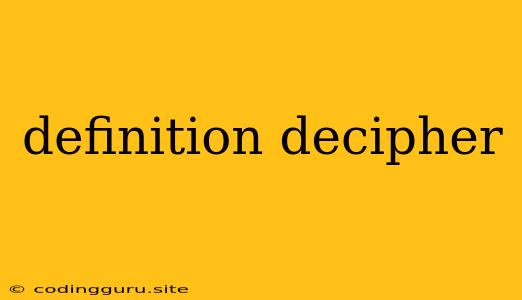What is Deciphering and Why is it Important?
In a world filled with cryptic messages, hidden codes, and enigmatic puzzles, deciphering stands as a crucial skill. It's the art of unlocking the meaning concealed behind a seemingly impenetrable veil of symbols, codes, or language. Whether it's cracking a secret code in a spy novel or unraveling the mysteries of an ancient inscription, deciphering plays a pivotal role in understanding the hidden layers of information.
What does Deciphering Mean?
Deciphering is the process of converting an encrypted message, code, or language into plain text, making it understandable. It involves breaking down complex systems of symbols, patterns, and rules to reveal the intended message. Deciphering can be applied to various fields, including:
- Cryptography: Cracking encryption algorithms used to secure sensitive data.
- Linguistics: Translating ancient languages and deciphering cryptic texts.
- Codebreaking: Uncovering secret messages used in espionage or warfare.
- Data Analysis: Extracting meaningful information from complex data sets.
- Problem Solving: Solving puzzles and riddles that require logical deduction.
How does Deciphering Work?
Deciphering relies on a combination of analytical skills, knowledge of cryptography, linguistics, and logic. It involves the following steps:
- Identification: Recognizing the type of encryption or code used.
- Analysis: Breaking down the cipher or code into its components.
- Pattern Recognition: Identifying patterns, repetitions, and inconsistencies.
- Deduction: Using logical reasoning to infer the meaning of symbols and codes.
- Translation: Converting the deciphered text into plain language.
Examples of Deciphering
Deciphering has a rich history, filled with fascinating examples:
- The Rosetta Stone: This ancient artifact allowed scholars to decipher the hieroglyphic language used in ancient Egypt.
- The Enigma Machine: During World War II, Allied codebreakers deciphered messages sent using this German encryption device.
- The Voynich Manuscript: This mysterious book, written in an unknown script, has baffled scholars for centuries.
Tips for Deciphering
- Start with the basics: Learn the fundamental principles of cryptography and codebreaking.
- Identify the type of cipher: Recognize the different types of ciphers used, such as substitution ciphers, transposition ciphers, or polyalphabetic ciphers.
- Look for patterns: Examine the text for recurring symbols, patterns, and frequency analysis.
- Use logical deduction: Apply reasoning and problem-solving skills to decipher the code.
- Consult resources: Use dictionaries, codebreaking guides, and online tools to aid in your efforts.
Deciphering in the Modern World
Deciphering remains relevant in today's digital age. Cryptography plays a vital role in securing our online data, and deciphering techniques are used to analyze and interpret complex data sets. Whether it's cracking a password, understanding encrypted messages, or deciphering complex algorithms, the ability to decipher information remains essential.
Conclusion
Deciphering is a fascinating and challenging endeavor that involves unraveling the hidden meaning behind coded messages. From ancient inscriptions to modern encryption algorithms, deciphering plays a crucial role in our understanding of the world and the information that surrounds us. By honing your analytical skills and embracing the principles of cryptography and logic, you can unlock the secrets hidden within coded messages and expand your knowledge of the unknown.
